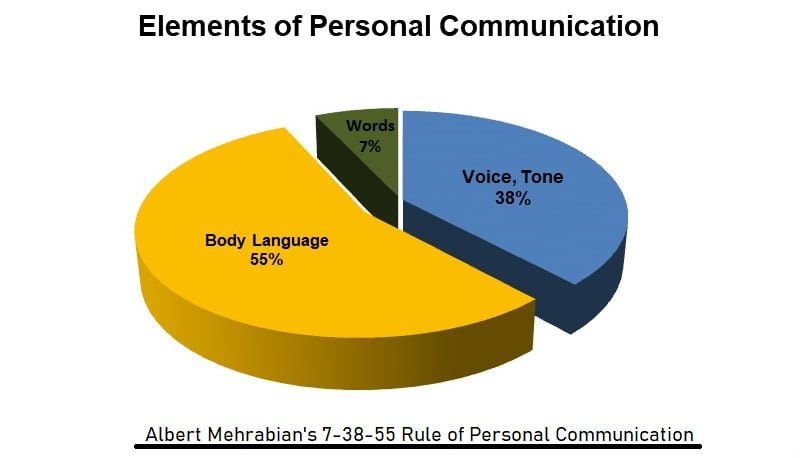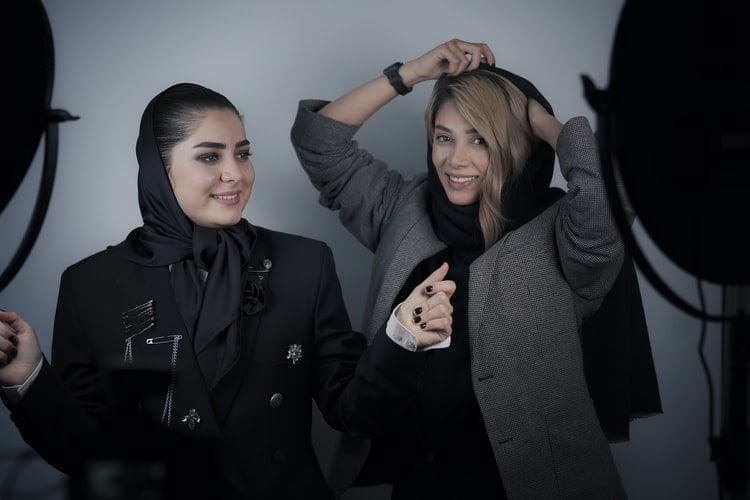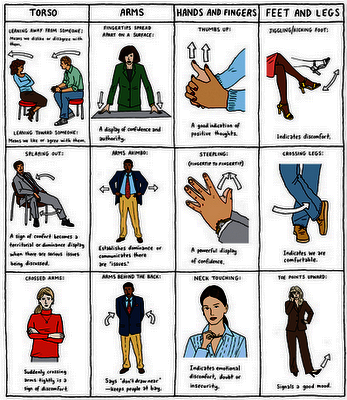Importance of Body Language in Communication
Body language is of core importance in communication. The Body language is misleading. A person can say one thing and think something completely different, or consciously deceive the interlocutor with lies. It is considerably more difficult to fool someone with body language since much of the body language expressions happen unconsciously. In many people, the facial expression and general posture clearly reveal what they are feeling. It can easily be noticed as it only needs to know how to interpret the signals.
However, some people have the ability to judge every moment in a conversation while other doesn’t. The one who knows how to interpret body language correctly has an amazing advantage in communicating with other people. If you are good at reading body language expressions and have some knowledge about it, you can read the inner feelings of the person in front of you and more easily create an atmosphere of trustful conversation.
Moreover, this knowledge has a positive impact on both personal and professional life. At the same time, understanding non-verbal cues is the first step in deliberately using your own body language and increasing your knowledge about this phenomenon. In this context, we don’t aim to consciously deceive others but to support what we express with an authentic and safe attitude.
So,
What is body language?
Body language is the most important form of non-verbal communication, since facial expression, body posture, and gestures are the most immediate expression of our emotions and feelings. It is because most of these signals are emitted unconsciously. Above all, in emotional moments of happiness, fear, anger, or sadness it is almost impossible to control such gestures and facial expressions.
Definition of Body Language:
Body language encompasses all the conscious and unconscious signals of the body that give information about the emotional state or the intentions of a person.
However, there are also conscious body signals that can be used deliberately in communication to make the conversation clearer. We use this body language in our daily conversations. However, arguments can be enhanced with hand gestures, and facial expressions can signal the willingness to talk or if there’s a need for calm.
Pie Diagram on Body Language in Nonverbal Communication:

Conscious and unconscious Body Language:
When we breathe impatiently, roll our eyes in annoyance, or purse our lips because we are offended, we are revealing our feelings, even if we do so for a fraction of a second. In the same way, just as these signals are emitted unconsciously, they can also be read unconsciously. This is the reason why there are some people that we do not like from the first moment, or that we are immediately passionate about it without being able to say exactly why. We perceive body language while concentrating on what is being said or letting our thoughts fly.
However, in addition to these unconscious body gestures, there are conscious bodily signals. These are trained and are marked by our cultural environment. We use them in the right situations to convey a certain message or to clarify what we are saying. Some typical examples are the index finger raised to express “attention” the thumb raised to express approval or to direct the palms of the hands to the person in front of us to clarify a situation or to mitigate an emotional outbreak. However, in these situations, one must be careful, as mindful body language must be read in the cultural context. Certain hand gestures and body postures can have completely different meanings on other continents or in other cultural circles. Here are the, 29 Powerful Tips For Personality Development.
Meaning of body language:
Body language has a great influence on the impression that how people live and what they express is assimilated. It has great importance when someone is delivering a presentation or speech. Take a look at video recordings of famous speakers. There it is easy to identify that not only the content of a speech contributes decisively to its success, but also the dynamics with which it is presented. Thus, among all other things, body language signals to viewers, how important the topic is to the speaker and thus constitutes a decisive criterion in their credibility.
However, in personal or work environments, people are also evaluated by how their body language adapts to what they say. There is nothing more disconcerting than a coworker who says with a blank face that he is taking care of the task, or a boss who looks relentlessly around the room while muttering that he finds the idea just presented interesting. These cases are a clear example of how we constantly read body language and how the attitude of other people often reveals more than the expression of verbal content. If the person in front of us sees a clear discrepancy between what is being said and what body language expresses, this will confuse or irritate him. The 10 Body Language Tips for Video Conferencing on Zoom or Skype.
In addition, body language also opens up communication possibilities, even if the same language is not spoken. Thus, in the first line, we find the gestures and facial expressions that are already used instinctively and that are understood in all parts of the world because they are directly related to the basic emotions of the human being. And a smile will be understood almost everywhere as a sign of accessibility and friendliness. In the case of all other gestures, it is important to ascertain the meaning in each of the cultural circles. For example, in Europe, a raised thumb usually signifies approval, while in Australia it is understood as a serious offense.
But!
Be Careful:
In communication sciences, the discipline of kinetics studies the application of movements in conversations. Analyze the effects of facial expressions, gestures, and body posture in special communication situations, such as in sales negotiations, contract negotiations, or in efforts to mitigate conflicts. The knowledge gained through kinetics is applied for example in the training of sales personnel, mediators, speakers, and social workers.

Explanation of body language with examples:
Body language and its signals play a vital role in our daily communication.
Do you know, you are using these body language signals and facial expressions in your daily communication?
This communication is characterized by a person’s facial expressions, body postures, gestures, and body movements.
The following examples show how even the smallest movements reveal our inner feelings.
Facial Expressions:
Facial expression encompasses all the movements and expressions that can be read on a person’s face. One of the best signs of facial expression is a smile. A smile is one of the most powerful masks one can wear on his/her face. It enables open communication with strangers, understanding, and joy, shows kindness, and is the best signal to start a conversation.
Emotions and feelings are transmitted, to a large extent, through the eyes and mouth, and the expressions of the face only intensify them. A look can denote interest, love, affection, absence, doubt, hatred, fear, curiosity, and we can perceive all this in fractions of a second.
- Interest/Curiosity: The eyes are awake and open and look calmly at the person who is speaking or the object that is being spoken to absorb all the information in a concentrated way. But beware: if direct eye contact lasts too long, other people quickly find it unpleasant or heavy.
- Disinterest: The view travels the room or the environment and stops here and there and then on other people and other events. A completely off-center, motionless gaze is a sign that someone has become self-absorbed and is focused on their own thoughts.
- Surprise: Eyes open sharply and eyebrows move upward.
- Anger: Eyes tighten, eyebrows are drawn together, and forehead is furrowed.
- Doubt: The gaze is concentrated, but the eyes are restless because the listener reflects at the same time if he can believe what is being said. Depending on the posture regarding what is being said, the eyebrows may flick up in disbelief or gather in irritation.
- Fear: The eyes also open sharply in fear; at the same time, the pupils are wide open to perceive all possible details of the threat.
If you want to learn how to read body language correctly, paying attention to the pupils is one of the best ways. They are especially treacherous, as their movements cannot be consciously controlled and nevertheless they clearly reflect emotions. Thus, the pupils dilate when we feel joy or other positive stimuli and narrow when we feel fear or aversion.
Gestures:
Neuroscientists have found that the areas of the brain responsible for memory and thought processing are adjacent to the area that manages gestures. This explains why some people gesticulate when speaking even when they are on the phone and no one can see them. The gestures serve in these cases to organize thoughts, establish references, and remember correctly. Thus, it is about processes that are carried out unconsciously and that must be clearly differentiated from the deliberate and acquired body gestures of the speakers, politicians, presenters, or performers.
Additionally, we find the gestures that we have learned throughout our lives and that serve to support our oral expressions: These gestures are:
- Welcome: The widely extended arms that lead to a hug or a greeting with the hand extended from afar are a sign of joy at the arrival of a person.
- Defense: The arms crossed with the palms raised directed towards the person in front of us serve to protect ourselves. They indicate that the other person should not approach.
- Anger: A clenched hand in the shape of a fist indicates that someone is trying to control themselves. If he gets up, it is understood as a violent threat.
- Calm the situation: The position of the hands is the same as in the defense position, but the arms are not crossed but are close to the body. With this gesture, we try to calm someone down and show that they have nothing to fear from us.
- Helplessness / Ignorance: When someone no longer knows what to do in a situation, they express it by repeatedly shrugging their shoulders.
These are just a few examples that show how the gestures of our hands serve in our daily lives to express certain messages. The study has shown that this way of reading body language and expressions is used in the same way by all people in a cultural circle.
Body Language Chart:

Image Source: getyourtips
Body posture and movement:
The body posture of a person clearly indicates their emotional state. It is rightly said that a happy person seems to float, while sad people, rather than walking, drag their feet with their shoulders hanging and their heads lowered. And you can also guess a person’s self-confidence through their body posture. When a boss rushes through the office with his chin raised, his chest puffed out and his steps wide, it is clear that he is aware of his role, confident, and considers himself a leader. On the other hand, hasty and nervous movements, such as hitting small tugs on clothes or hair, or quickly swinging the feet seated on the edge of the chair, indicate insecurity and give the impression that the person wants to flee the situation.
Body Movement:
The body posture and movement cannot be separated from each other in practice. A certain body posture requires a certain type of movement. It is highly unlikely that a person with an upright confident posture that shows pride will walk shyly, or that a person who walks down the street in a hunched and sunken way will do so with long strides.
Moreover, there are certain expressions and movements that offer direct messages. For example, this category includes, exceeding a suitable distance between two people. The moment from which we find ourselves uncomfortable depends a lot on the person in front of us. In general, we allow those acquaintances we find friendly to approach at a relatively short distance. In the case of strangers, and especially superiors, a certain distance shows respect. If someone gets too close, it can be considered threatening or degrading. In any case, this is a boundary violation that will rarely provoke a positive reaction.
How to use body language deliberately in communication at work?
Now as the different kinds of body language and expressions have been exposed with examples, we can only clarify how we can apply this knowledge in communication at work. In a working environment, one of the communication soft skills of an employee is that he knows how to apply and how to read the body language correctly.
Body Language in a job interview:
In the job interview, body language plays a decisive role. Psychiatrists are especially invited to a job interview to thoroughly observe the body language of an applicant. The time when the two parties can form an impression is limited and, therefore, non-verbal cues have a much stronger influence than normal on the assessment of both parties; since at that moment only technical skills are discussed, but a truly realistic impression of them cannot be given.
For job applicants, it is important to leave a distinguished and confident, but not arrogant, impression on the interviewer. Make sure you are aware in advance of what gestures reveal your nervousness and deliberately try to avoid them. For example, people who play with locks of hair or pull at their beards may try to clasp their hands in their laps. Moreover, during the interview, you should sit relaxed but upright. If you lean back in the chair cross-legged, you’ll soon appear uninterested and unmotivated.
On the other hand, those conducting the interview should pay attention to emitting positive signals to create a relaxed environment for the interview and to calm the applicant. One can do this with a friendly facial expression and occasional questions. In case you have critical questions, do not confront the applicant directly. Instead, he applies the effective sandwich technique, combining criticism with the mention of positive aspects and thus taking the issue away. Here’s the Body Language Do’s and Don’ts in a Job Interview.
Role of Body Language in Negotiations:
Negotiations are also another typical situation where body language plays an important role. It does not matter whether it is contract negotiations with clients or a salary negotiation with the boss: these negotiations are characterized by the fact that the negotiators have different pretensions and an agreement must be reached. The aspects of the negotiations that we have already discussed are also useful in this case. However, you can also use deliberate gestures with which to indicate to the interlocutor our sympathy and at the same time clearly defend our opinion.
Here are the Secret Body Language Signals in a Romantic Relationship.
Mirror Technique:
The mirror technique is an effective strategy for negotiation, in which small gestures of the speaker are separately acquired and thus quietly indicate that in principle there is agreement and be able to fully understand the opposite position. If the conversation threatens to escalate into a heated argument, changing the seating arrangements can help defuse the situation.
If, for example, at first you were sitting in front of the interlocutor, you can use some pretext to change your place next to the person with whom you are negotiating, as long as the characteristics of the place where you allow it. At the end of the day, this indicates that you both have the same objective in mind and that you just have to agree on the best possible action to get there.
If the conversation has already started, pacifying gestures, such as revealing one or both palms of the hand or calmly lowering the hands can ease the tension.
However, we must not allow ourselves to get away from our own point of view and, if the situation allows it, we can clearly indicate this. In this way, crossing our arms, something that we should normally avoid in conversations, in this context is a sign that the limits have been exceeded and that we are not going to allow ourselves to be further removed from our pretensions.
Whatever strategy you decide on, the important thing is that you do not get carried away by your emotions and that you always keep the sense that tells you which signals are recommended and useful. Then you can use your body language deliberately and to your advantage.
Discussed above are some of the main body language techniques and expressions that we can use to make our communication skills more effective and also to improve our personalities. No doubt, we all use these expressions in our daily conversations and if we know about some of the above advantages, we can further nourish them.
What are the body language expressions that are commonly used in your cultural environment?
You might also like:
Interpersonal Communication: Definition, Importance, and Skills
How to Read Body Language | 6 Ways to Recognize Nonverbal Cues
Nonverbal Communication: Body Language Secrets of Successful People
